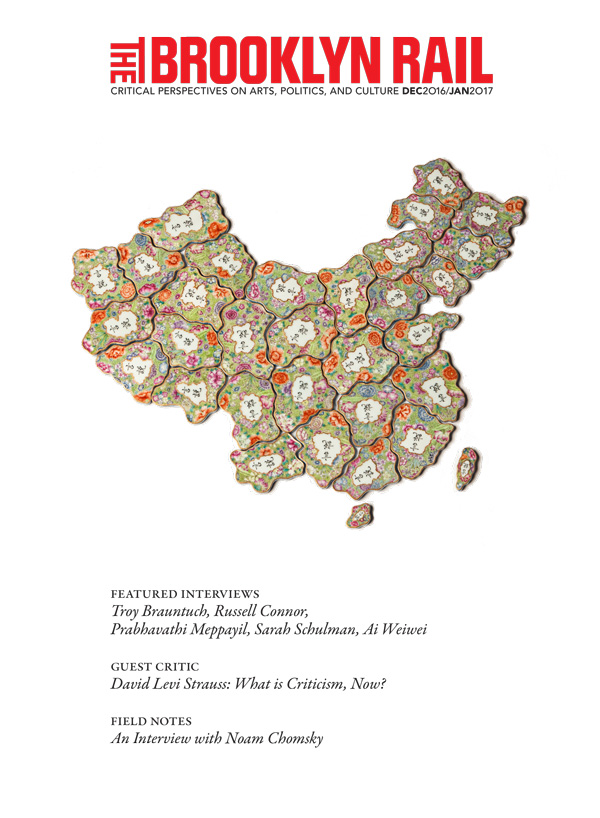Doris Salcedo The Materiality of Mourning
by Timothy Francis Barry
Harvard University Art Museums
November 4, 2016 – April 9, 2017
Pop culture has had a tumescent rocket in its pocket for Latin American revolutionaries since Pancho Villa first strapped on a bandillera around 1910: witness Che’s handsome profile tattooed on a thousand biceps, remember The Clash immortalizing the Sandinistas with a triple-record set, and if you can think of a more poetic tag for a death-squad than Shining Path, I’m all ears.
 Installation view: Thou-less (detail) and untitled chair works in Doris Salcedo: The Materiality of Mourning, on display November 4, 2016 – April 9, 2017 at the Harvard Art Museums. © Doris Salcedo. Photo: Harvard Art Museums; © President and Fellows of Harvard College.
Installation view: Thou-less (detail) and untitled chair works in Doris Salcedo: The Materiality of Mourning, on display November 4, 2016 – April 9, 2017 at the Harvard Art Museums. © Doris Salcedo. Photo: Harvard Art Museums; © President and Fellows of Harvard College.Maybe there was something romantic about banana-republic rebels—not any more. If their goal, beginning in the 1960s, was better living through Marxism, the methods Colombia’s FARC revolutionaries employed quickly became deadly: whole villages torched, pipe bombs tossed into busy health clubs. Soon they caught on to drug-thug-funding, their Russian-made PKM assault-rifles and rocket-launchers got a lot more numerous, and the people of Colombia got a lot more terrified.
By the ’80s, right-wing paramilitary groups took on the leftists; full-blown civil war arrived, and murder became a daily thing. And it didn’t go away: even in 2012 the city of Medellín had over 175 killings by motorcycle-riding assassins—many of them teenagers. Colombia has become synonymous with outrageous carnage that would make Hieronymus Bosch look away, trembling.
If you’re the Colombian sculptor and conceptual artist Doris Salcedo, you don’t look away. You stare straight into the eye of evil, and the result is a body of work that invites us, through the poetry of her installations, to stare with her.
You don’t really need a history lesson to look at Salcedo; though her work’s roots are Colombian drive-bys and kidnap victims who never return, it is the global history of violence, its human cost, that her work sets out to document.
Salcedo’s poetic constructs (seen in a towering survey last year at the Guggenheim and now in a concise but very pointed exhibition in Cambridge, Massachusetts, at the Harvard Art Museums) subtly and quietly encourage the viewer to meditate. What she is saying is not readily apparent. But as with the best poetry, meanings accrue. Sensations and emotions mount, and when they come home to roost, the impact is all the more powerful for its slow build.
Case in point: Thou-less (2001 – 02), a room full of deformed chairs. All painted a cheery silver. There’s nobody sitting in these chairs, which are not lined up, but placed in what seem random groupings. Who once sat in these chairs? Are the former sitters all dead? You can’t ask.
At a talk at Harvard this November, Salcedo offered this: “My pieces are absurd, they don’t make sense: like political violence. The artist’s job is to narrate, to reiterate.”
One narrative here is a group of four spectral wall hangings from the “Disremembered” series (2014 – 16), at first glance beautiful, draped fabric forms—maybe blouses, maybe blankets—but which on closer inspection reveal to be fashioned from handwoven silk threads, filled with tiny needles—16,000 of them. As Salcedo put it, “each needle represents one memory.”
One large gallery houses two of her signature pieces: hulking combines wrought of broken furniture pieces and concrete, suggesting coffins, mausoleums. No explanation necessary. The poet speaks of “the political consequences of remaining silent.” Here, a different kind of silence imparts a message.
Like Ai Weiwei, her fellow traveler on the art-as-dissidence world stage, Salcedo takes a page from the absurdist French dramatist Eugène Ionesco’s 1952 The Chairs, in which the household items become metaphorical shorthand for absence and the unexplainable. Both sculptors have used chairs in a variety of installations and interventions.
Words barely suffice to describe A Flor de Piel (2013)—The Flower Petals. What looks like a wave of slowly spreading blood fills a large area of the room. This shroud-like abstraction was produced by treating thousands of rose petals with mineral spirits, red dye, glycerin, and wax, then stitching them together.
Visitors to the installation crouch or kneel at its edge, lending the work a funereal vibe. The impulse is strong to lift the veil, to see if the amorphous lumps hide a body underneath.
Intended to memorialize a nurse who was tortured to death in the Colombian Civil War, it also draws power from the traditions of process art, wherein unstable materials seem destined to slowly decompose, evoking the ravages of time, and yet again, death. (Though in point of fact, the shroud was created with input from art-conservators, the aim being to give it a better chance at long-term existence.)
A rose is a rose is a rose. Or, as Martin Heidegger put it, “what is pre-given to the poet … can be re-given in the poem.”
Contributor
Timothy Francis Barry



























